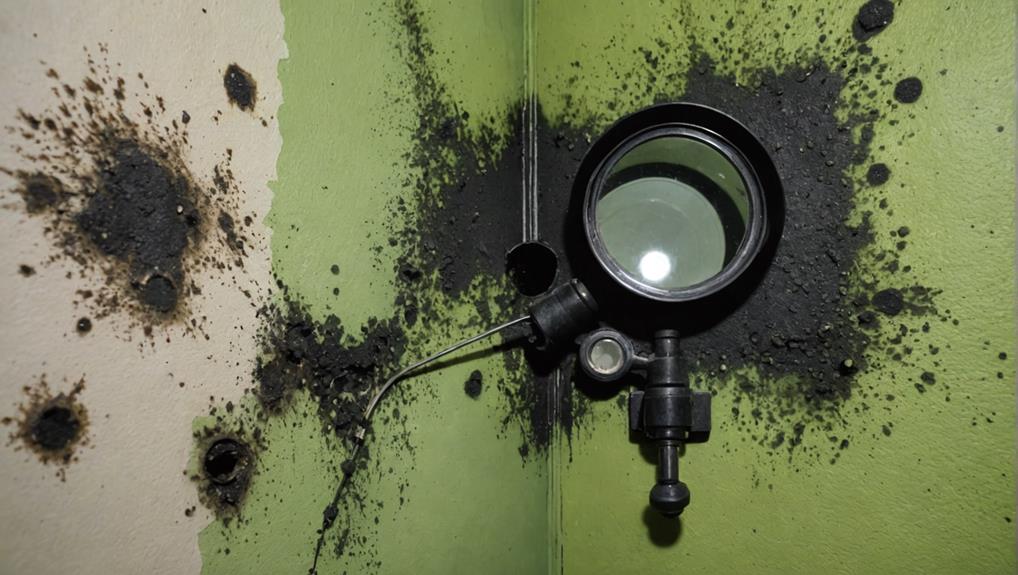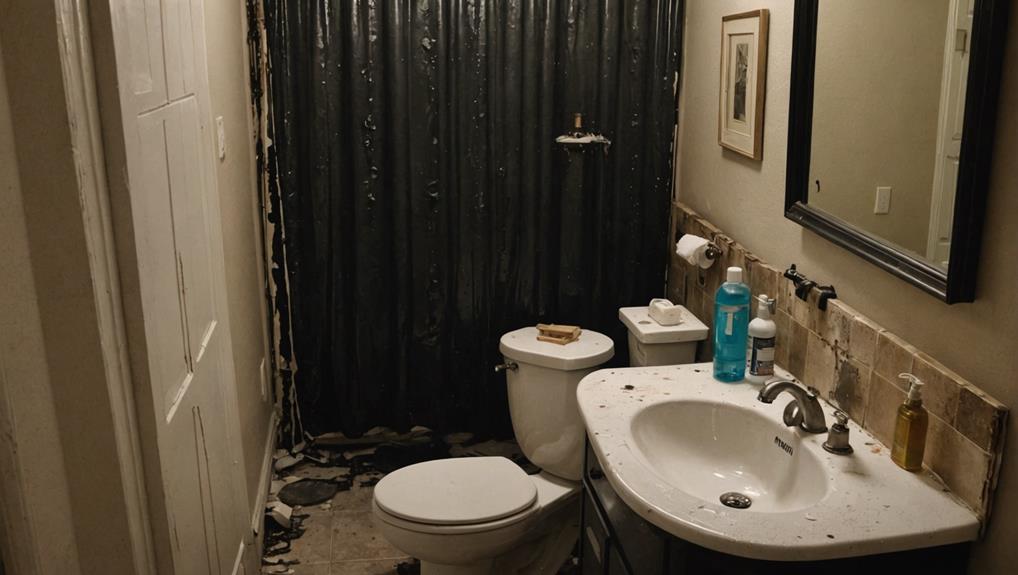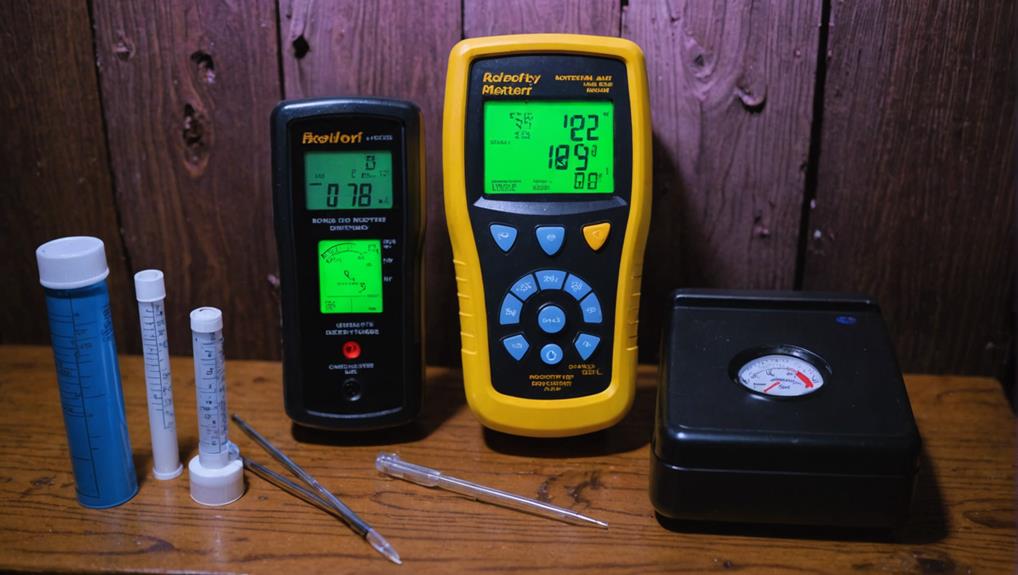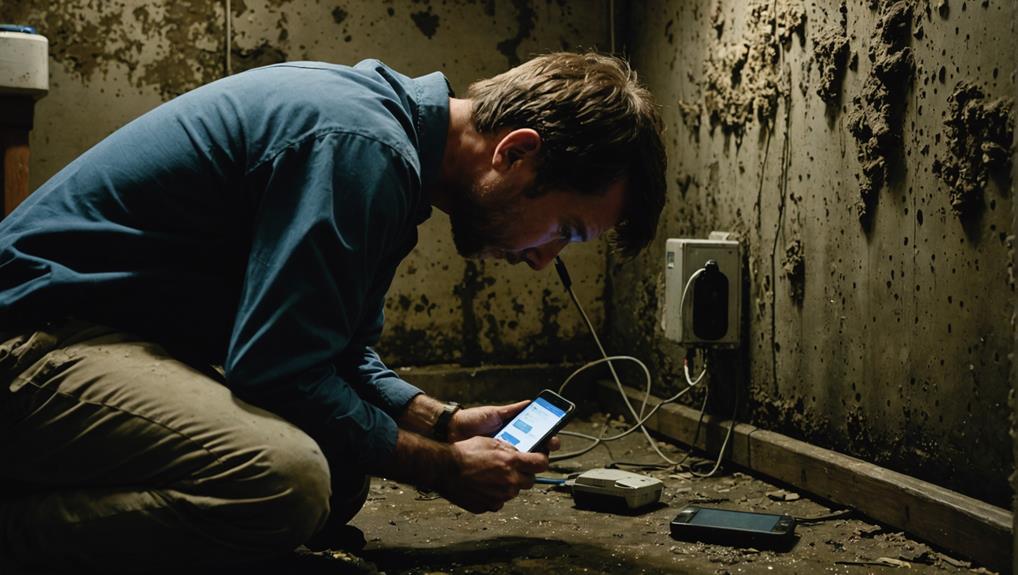To spot and eliminate hidden mold in your home, start with visual inspections for discoloration or water stains, particularly in high-moisture areas like bathrooms and basements. Utilize moisture meters to detect dampness in materials, and consider infrared cameras for hidden moisture behind walls. Musty odors often signal concealed mold, which can pose health risks like respiratory issues. For removal, small patches may be manageable through DIY methods, but larger infestations typically require professional intervention. Staying vigilant with regular inspections and moisture control is key to prevention. Investigate further to uncover thorough strategies and vital tools for effective mold management.
Understanding Mold Growth

Mold growth is a common issue that often goes unnoticed until it becomes a major problem. Understanding the mold lifecycle is essential for anyone aiming to maintain control over their environment. Mold begins its lifecycle as spores, microscopic entities that can remain dormant for extended periods. Once conditions become favorable—typically involving moisture, organic material, and suitable temperatures—these spores germinate and develop into mycelium. This is the vegetative part of the mold and is where growth intensifies, leading to potential infestations.
Different mold species exhibit varying growth rates and preferences for specific conditions. For instance, Stachybotrys chartarum, often referred to as black mold, thrives in high humidity environments, while Aspergillus species may proliferate in drier conditions. Recognizing the environmental factors that contribute to mold growth empowers you to take proactive measures. Regular monitoring of humidity levels, along with immediate remediation of water leaks, can greatly inhibit the mold lifecycle. By understanding these dynamics, you arm yourself with the knowledge to prevent mold species from taking root in your home, thereby protecting both your health and your property.
Common Signs of Mold
Identifying the presence of mold in your home can sometimes be tricky, especially since it often grows in hidden areas. Nevertheless, recognizing the common signs can empower you to take action before the situation escalates. First, be vigilant for visible mold growth, which can appear as black, green, or white spots on surfaces. Different mold types thrive in various environments, so knowing their characteristics is essential.
Next, pay attention to musty odors. If you notice an unpleasant, earthy smell, it could indicate mold lurking in concealed spaces. Furthermore, if you observe water stains on walls or ceilings, it's a strong signal that moisture sources are present, creating an ideal breeding ground for mold.
Don't ignore health symptoms either; persistent coughing, sneezing, or skin irritation can be linked to mold exposure. Finally, check for condensation on windows or walls, which often signifies excessive humidity levels. By understanding these signs, you empower yourself to identify mold issues in their infancy, allowing you to address them effectively before they become a more significant problem. Taking control now can safeguard your home and health from potential mold invasions.
Areas Most Prone to Mold

Bathrooms and showers are often humid environments, making them prime locations for mold growth. Likewise, basements and crawl spaces typically have poor ventilation and higher moisture levels, which further contribute to mold infestations. Understanding these areas' vulnerabilities can help you take proactive steps to prevent mold from taking hold in your home.
Bathrooms and Showers
With high humidity levels and frequent moisture exposure, areas like showers and bathrooms are often breeding grounds for mold growth. To effectively combat this issue, you need to prioritize mold prevention strategies. Start by ensuring proper bathroom ventilation; installing an exhaust fan can greatly reduce humidity levels after showers. Furthermore, be vigilant about shower sealing. Check the caulking and grout regularly, as damaged seals can lead to water infiltration, creating ideal conditions for mold.
Establishing consistent cleaning routines is vital in maintaining a mold-free environment. Use mold-resistant cleaners and focus on high-moisture areas, including tiles, shower curtains, and any nooks where water can accumulate. Moisture control is key; consider using a dehumidifier if your bathroom remains damp after use.
Basements and Crawl Spaces
Mold proliferation in basements and crawl spaces is a common concern due to their inherent moisture retention and limited airflow. To effectively combat this issue, you need to implement robust moisture control and ventilation strategies. Poor insulation can worsen humidity levels, creating a breeding ground for mold. Regular seasonal maintenance is crucial—inspect your sump pump and drainage solutions to verify they function properly, preventing water accumulation.
Here's a quick reference table to help you identify potential mold risk factors in these areas:
| Risk Factor | Solution |
|---|---|
| High Humidity Levels | Install dehumidifiers |
| Insulation Issues | Upgrade insulation materials |
| Soil Moisture | Improve drainage systems |
| Poor Air Quality | Improve ventilation strategies |
Monitoring humidity levels and addressing any insulation issues promptly will improve air quality and minimize mold growth. Furthermore, choose building materials wisely, opting for mold-resistant options wherever possible. By taking proactive steps, you can safeguard your basements and crawl spaces from hidden mold invasions. Remember, diligence in monitoring these areas is key to maintaining a healthy home environment.
Health Risks Associated With Mold
Hidden within the corners of your home, mold can pose serious health risks that often go unnoticed until symptoms arise. Many people underestimate the effects of mold exposure, but it's imperative to recognize that even small amounts can trigger significant health concerns. Symptoms awareness is fundamental; you may experience allergic reactions, chronic coughing, sneezing, or skin irritation.
For those with pre-existing respiratory issues, mold can worsen conditions like asthma or bronchitis, leading to severe complications. Mold spores can infiltrate your lungs, causing inflammation and respiratory distress, which is particularly dangerous for children and the elderly.
Moreover, certain molds produce mycotoxins, which can lead to more severe health problems, including neurological symptoms and immune system suppression. If you notice a persistent musty odor or unexplained health issues, consider the potential presence of hidden mold.
Understanding the health risks associated with mold is crucial for maintaining your home's safety and your family's well-being. Don't dismiss the symptoms; take proactive measures to address mold growth before it escalates into a more serious threat to your health.
Tools for Mold Detection

Frequently overlooked, detecting mold in your home requires the right tools and techniques to guarantee a thorough assessment. Equip yourself with crucial mold detection tools to effectively identify and address mold issues. Start with moisture meters, which measure the moisture content in materials, helping you pinpoint areas at risk. Infrared cameras are invaluable for revealing hidden moisture behind walls, allowing for proactive intervention.
Conduct regular air quality tests using mold test kits to assess airborne spores. For a more hands-on approach, consider surface sampling, which allows you to collect samples from suspected areas for laboratory analysis. Visual inspections should never be underestimated; look for discoloration or water damage.
In addition, utilize humidity monitors to maintain ideal indoor humidity levels, ideally between 30% and 50%. If you prefer a DIY approach, various DIY kits are available for initial assessments. Nevertheless, for more thorough evaluations, professional services may be necessary, given their access to advanced technologies and expertise. By leveraging these tools, you empower yourself to tackle mold issues effectively, ensuring a healthier living environment.
Steps to Identify Hidden Mold
Understanding how to effectively identify hidden mold is crucial for maintaining a safe home environment. Start by employing various mold detection methods, such as visual inspections and moisture assessments. Look for water stains, discoloration, or a musty odor, which often indicate mold growth. Utilize moisture meters to pinpoint areas with increased humidity levels, as these are prime candidates for hidden mold.
Next, examine high-risk areas like basements, attics, and behind appliances where moisture often accumulates. Remember, mold thrives in dark, damp environments. Implement moisture control strategies by ensuring proper ventilation and sealing leaks promptly to deter mold proliferation.
Don't overlook hidden spaces; check under sinks and behind walls, as mold can often lurk out of sight. If you suspect significant mold presence, consider using specialized mold detection kits or hiring professionals for thorough assessments.
Mold Remediation Techniques

When it comes to mold remediation, you have options ranging from DIY methods to professional removal services. DIY techniques can be effective for small areas, but understanding the risks and proper procedures is vital. For extensive infestations, engaging a professional guarantees thorough removal and helps prevent future growth.
DIY Remediation Methods
Addressing mold issues in your home can be intimidating, but DIY remediation methods offer a practical solution for many homeowners. First, you'll want to identify the affected areas. Common hotspots include bathrooms, basements, and around windows. Once you've pinpointed the mold, it's crucial to gear up with protective clothing, gloves, and a mask to prevent exposure.
One effective approach is using natural mold removers like vinegar or baking soda. Vinegar can kill about 82% of mold species and is safe for most surfaces. Simply spray undiluted vinegar onto the moldy area, let it sit for an hour, then scrub and rinse. Baking soda, on the other hand, can be combined with water to create a paste. Apply this to the mold, scrub, and rinse thoroughly.
Don't forget mold prevention tips! Guarantee proper ventilation in high-moisture areas, fix leaks promptly, and use dehumidifiers when necessary. Regularly inspect your home for signs of mold to stay ahead of potential problems. By employing these DIY methods, you can effectively tackle mold issues and maintain a healthy living environment.
Professional Mold Removal
While DIY methods can be effective for minor mold issues, more extensive infestations often require professional mold removal services. These experts utilize advanced mold removal techniques to guarantee your home is not just cleaned, but thoroughly remediated.
A professional assessment is vital in identifying the extent of the mold problem, including hidden colonies that may be lurking behind walls or under flooring. This all-encompassing evaluation allows specialists to pinpoint moisture sources, which is key to preventing future growth.
Once the assessment is complete, these professionals deploy sophisticated equipment, such as air scrubbers and dehumidifiers, to contain and eliminate mold spores from your environment. They often follow a systematic approach, starting with containment to prevent cross-contamination, then using specialized cleaning solutions that effectively eradicate mold without damaging your property.
Additionally, professionals can provide a post-remediation verification, confirming that all mold has been removed and that your home is safe. By opting for professional mold removal, you're not just addressing the visible signs of mold; you're taking decisive action to protect your home and health from its harmful effects.
Preventing Future Mold Growth
Preventing future mold growth in your home requires a proactive approach to moisture management and environmental control. To start, focus on ventilation improvements. Make certain that areas prone to moisture, like bathrooms and kitchens, have exhaust fans that effectively remove humid air. Consider installing vents in your attic and crawl spaces to promote air circulation, which can greatly reduce moisture buildup.
Next, prioritize humidity control. Ideally, indoor humidity levels should remain between 30% and 50%. You can achieve this by using dehumidifiers in damp areas and regularly checking for leaks or water accumulation. Repair any plumbing issues promptly, as even minor leaks can create a favorable environment for mold growth.
Furthermore, consider using mold-resistant materials in your home, especially in areas susceptible to dampness, like basements and bathrooms. Paint with mold-inhibiting properties can likewise be an excellent preventive measure.
Regularly inspect your home for signs of water damage or humidity issues, and address them immediately. By implementing these strategies, you can empower yourself to maintain a mold-free environment, greatly reducing the risk of future infestations.
When to Call Professionals

If you notice signs of severe mold infestation, such as extensive discoloration or a musty odor, it's essential to assess the situation promptly. Ignoring these indicators can lead to significant health risks, especially for individuals with respiratory issues or weakened immune systems. Furthermore, complex removal procedures often require professional expertise to guarantee safe and effective remediation.
Signs of Severe Infestation
When evaluating your home for mold, recognizing the signs of a severe infestation is crucial for safeguarding your health and property. If you notice a persistent musty odor, it's often indicative of hidden mold types, especially if it's accompanied by visible mold growth, such as black spots or fuzzy patches. Pay attention to areas with high moisture levels, like basements, bathrooms, or around plumbing leaks, as they're common infestation causes.
Another vital sign is water damage—stains on walls, ceilings, or floors can signal that mold is thriving behind the surfaces. If you're experiencing unexplained allergic reactions, respiratory issues, or constant fatigue, these symptoms may suggest a severe mold problem. Remember, the longer you wait, the more extensive the damage can become, leading to costly repairs.
If you encounter any of these signs, it's time to call professionals. They possess the expertise and tools necessary to identify the specific mold types in your home and effectively eliminate them, ensuring a safe living environment. Don't underestimate the significance of acting swiftly to protect your health and property from a severe mold infestation.
Health Risks Assessment
Identifying the health risks associated with mold exposure is important for maintaining your well-being and that of your family. Mold allergies can lead to a range of health symptoms, including sneezing, coughing, and skin irritation. If you or your family members experience respiratory issues, it's necessary to reflect on the possibility of toxic exposure from mold, particularly in enclosed spaces with poor indoor air quality.
Long-term effects of mold exposure can worsen existing health conditions, especially for those with compromised immune responses. Environmental factors such as humidity and moisture control play significant roles in mold growth; consequently, effective mold prevention strategies are critical.
If you notice persistent health symptoms linked to mold, or if you suspect a severe infestation, it's time to call professionals. They can assess the situation thoroughly, taking into account the potential toxic effects and offer solutions tailored to your home's specific needs. Remember, addressing mold issues promptly is not just about aesthetics; it's about safeguarding your family's health and ensuring a safe living environment. Prioritize proactive measures for moisture control and indoor air quality to lessen risks associated with mold.
Complex Removal Procedures
How can you determine when it's time to call in professionals for mold removal? While small mold patches can sometimes be managed on your own, certain situations demand expert intervention to guarantee your home's safety and structural integrity. If you encounter extensive growth—beyond 10 square feet—or if the mold is present in hidden areas like walls or behind appliances, it's prudent to seek professional help.
Consider these key factors:
- Chemical Alternatives: Professionals have access to advanced chemical alternatives that effectively eliminate mold while minimizing health risks.
- Safety Precautions: Certified mold remediation specialists understand the necessary safety protocols to protect both themselves and your family during the removal process.
- Comprehensive Assessment: Experts can perform thorough assessments to identify the source of moisture, guaranteeing that the problem doesn't return after removal.
Maintaining a Mold-Free Home
To maintain a mold-free home, regular monitoring and proactive measures are essential. Start by implementing effective mold prevention strategies. Regularly inspect high-risk areas like basements, bathrooms, and kitchens for any signs of moisture or mold growth.
Indoor humidity control is critical. Aim to keep indoor humidity levels below 50%. Utilizing dehumidifiers, especially in damp areas, can greatly reduce moisture accumulation. Guarantee proper ventilation in areas prone to humidity, such as using exhaust fans while cooking or showering.
Check your home's gutters and downspouts to prevent water from pooling near the foundation, as this can lead to increased humidity indoors. Moreover, repair any leaks in plumbing, roofs, or walls immediately to minimize moisture intrusion.
Consider using mold-resistant materials in your home, such as drywall and paint, which can provide an extra layer of protection. In addition, maintain a routine cleaning schedule that includes using mold-inhibiting solutions on surfaces that are prone to dampness.
Conclusion
So, it turns out, you don't actually want a hidden mold colony thriving in your home, in spite of how charmingly it might decorate your walls. By understanding mold growth, recognizing signs, and employing effective detection and remediation techniques, you can reclaim your space. Just remember, prevention is key—because who wouldn't want to trade the cozy ambiance of a mold-infested home for a clean, fresh atmosphere? After all, mold isn't exactly the ideal housemate you'd wish for!
